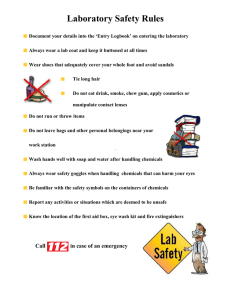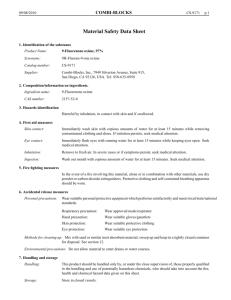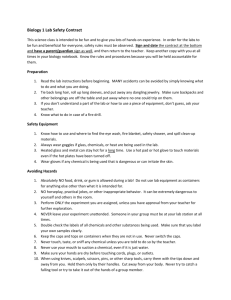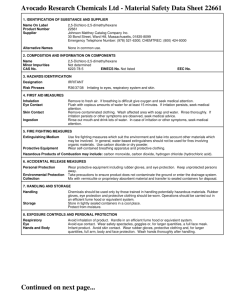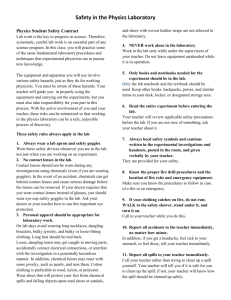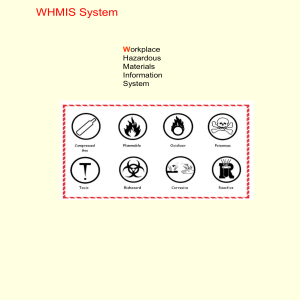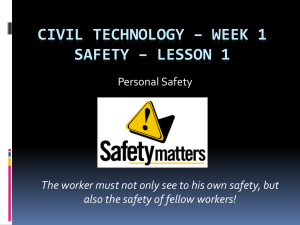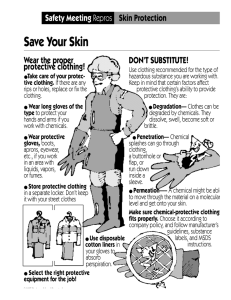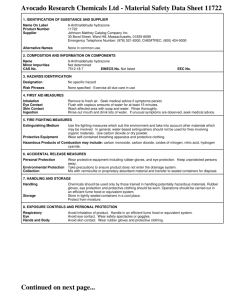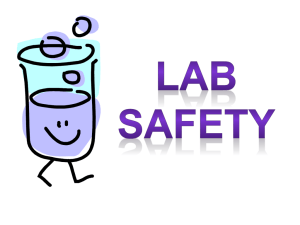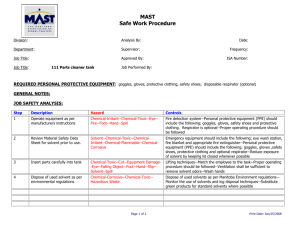Lab Safety
advertisement
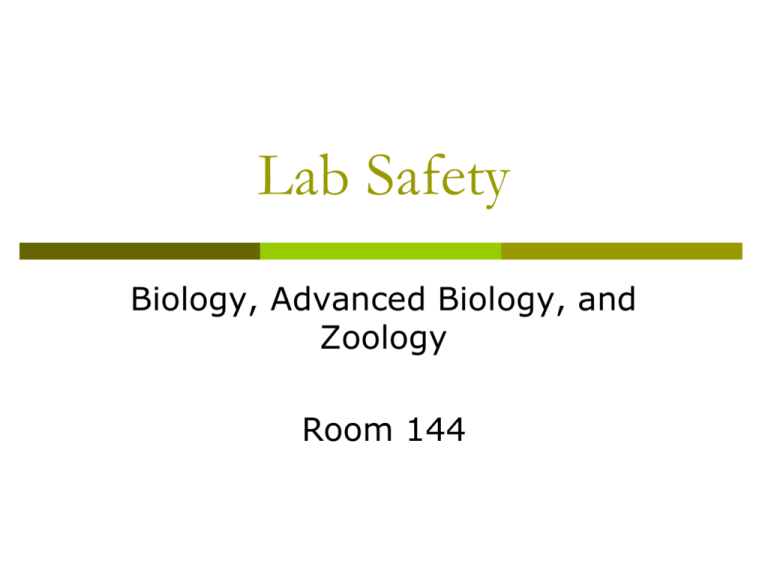
Lab Safety Biology, Advanced Biology, and Zoology Room 144 Laboratory Safety Your biology laboratory is a unique place where you can learn by doing things that you couldn’t do elsewhere. It also involves some dangers that can be controlled if you follow these safety notes and all instructions from your teacher. It is YOUR responsibility to protect yourself and other students by conducting yourself in a safe manner while in the laboratory. Familiarize yourself with the printed safety symbols – they indicate additional measures that you must take. While in the Laboratory at All Times… Familiarize yourself with a lab activity – especially safety issues – before entering the lab. Know the potential hazards of the materials, equipment, and the procedures required for the activity. Ask the teacher to explain any parts you do not understand before you start. While in the Laboratory at All Times… Never perform any experiment not specifically assigned by your teacher. Never work with any unauthorized material. While in the Laboratory at All Times… Never work alone in the laboratory. While in the Laboratory at All Times… Know the location of all safety and emergency equipment used in the laboratory. Examples include eyewash stations, safety blankets, safety shower, fire extinguisher, first-aid kit, and chemical spill kit. While in the Laboratory at All Times… Know the location of the closest telephone, and be sure there is a posted list of emergency phone numbers, including poison control center, fire department, police, and ambulance. While in the Laboratory at All Times… Before beginning work: tie back long hair, roll up loose sleeves, and put on any personal protective equipment as required by your teacher. Avoid or confine loose clothing that could knock things over, ignite from a flame, or soak up chemical solutions. While in the Laboratory at All Times… Report any accident, incident, or hazard – no matter how trivial – to your teacher immediately. Any incident involving bleeding, burns, fainting, chemical exposure, or ingestion should also be reported to the school nurse or physician. While in the Laboratory at All Times… In case of fire, alert the teacher and leave the laboratory. While in the Laboratory at All Times… Never eat, drink, or apply cosmetics. Never store food in the laboratory. Keep your hands away from your face. Wash your hands at the conclusion of each laboratory activity and before leaving the laboratory. Remember that some hair products are highly flammable, even after application. While in the Laboratory at All Times… Keep your work area neat and uncluttered. Bring only books and other materials that are needed to conduct the experiment. While in the Laboratory at All Times… Clean your work area at the conclusion of the lab as your teacher directs. Eye Safety Wear approved chemical safety goggles as directed. Goggles should always be worn whenever you are working with a chemical or chemical solution, heating substances, using any mechanical device, or observing a physical process. In case of eye contact Go to an eye wash station and flush eyes with running water for at least 15 minutes Notify your teacher or other adult in charge Wearing contact lenses for cosmetic reasons is prohibited in the laboratory. Liquids or gases can be drawn up under the contact lens and into direct contact with the eyeball. If you must wear contact lenses prescribed by a physician, inform your teacher. Never look directly at the sun through any optical device or lens system, or gather direct sunlight to luminate a microscope. Such actions will concentrate light rays that will severely burn your retina, possible causing blindness! Electrical Supply Never use equipment with frayed cords. Ensure that electrical cords are taped to work surfaces so that no one will trip and fall and so that equipment can’t be pulled off the table. Never use electrical equipment around water or with wet hands or clothing. Clothing Protection Wear an apron or lab coat when working in the laboratory to prevent chemicals or chemical solutions from coming in contact with skin or contaminating street clothes. Confine all loose clothing and long jewelry. Animal Care Do not touch or approach any animal in the wild. Be aware of poisonous or dangerous animals in any area where you will be doing outside fieldwork. Always obtain your teacher’s permission before bringing any animal (or pet) into the school building. Handle any animal only as your teacher directs. Mishandling or abuse of any animal will not be tolerated! Sharp Object Safety Use extreme care with all sharp instruments, such as scalpels, sharp probes, and knives. Never use double-edged razor blades in the laboratory. Never cut objects while holding them in your hand. Place objects on a suitable work surface. Chemical Safety Always wear appropriate personal protective equipment. Safety goggles, gloves, and an apron or lab coat should always be worn when working with any chemical or chemical solution. Never taste, touch, or smell any substance or bring it close to your eyes, unless specifically told to do so by your teacher. If you are directed by your teacher to note the odor of a substance, do so by waving the fumes toward you with your hand. Never pipette any substance by mouth; use a suction bulb as directed by your teacher. Always handle any chemical or chemical solution with care. Check the label on the bottle and observe safe-use procedures. Never mix chemicals unless specifically told to do so by your teacher. Never pour water into a strong acid or base. The mixture can produce heat and can splatter. Report any spill immediately to your teacher. Check for the presence of any source of flames, sparks, or heat before working with flammable liquids or gases. Plant Safety Do not ingest any plant part used in the laboratory. Do not rub any sap or plant juice on your eyes, skin, or mucous membranes. Wear protective gloves when handling any wild plant. Wash hands thoroughly after handling any plant or plant part. Avoid touching your hands to your face and eyes. Do not inhale or expose yourself to the smoke of any burning plant. Do not pick wildflowers or other plants unless directed to do so by your teacher. Proper Waste Disposal Clean and decontaminate all work surfaces and personal protective equipment as directed by your teacher. Dispose of all sharps (broken glass) and other contaminated materials in special containers as directed by your teacher. Hygienic Care Keep your hands away from your face and mouth. Wash your hands thoroughly before leaving the laboratory. Remove contaminated clothing immediately. When handling bacteria or similar microorganisms, use the proper technique demonstrated by your teacher. Return all stock and experimental cultures to your teacher for proper disposal. Heating Safety When heating chemicals or reagents in a test tube, never point the test tube toward anyone. Use hot plates, not open flames. Know the location of laboratory fire extinguishers and fire blankets. Use tongs or appropriate insulated holders when heating objects. Keep combustibles away from heat and other ignition sources. Hand Safety Never cut objects while holding them in your hand. Wear protective gloves when working with stains, chemicals, chemical solutions, or wild plants. Glassware Safety Inspect glassware before use; never use chipped or cracked glassware. Do not attempt to insert glass tubing into a rubber stopper without specific instruction from your teacher Always clean up broken glass by using tongs and a brush and dustpan. Discard the pieces in an appropriately labeled “sharps” container. Safety With Gases Never directly inhale any gas or vapor. Do not put your nose close to any substance having an odor. Handle materials prone to emit vapors or gases in a well-ventilated area. This work should be done in an approved chemical fume hood.
